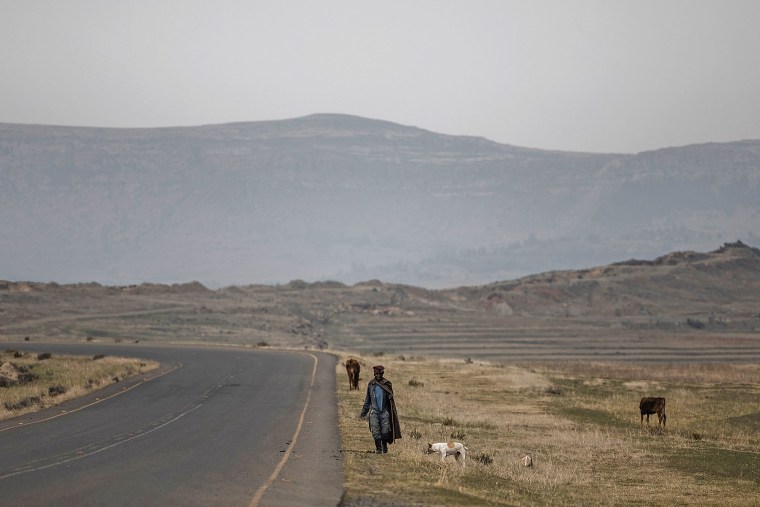A 50% reciprocal trade tariff on Lesotho, the highest levy on U.S. President Donald Trump’s long list of target economies, will kill the tiny Southern African kingdom that Trump ridiculed last month, an economic analyst there said on Thursday.
Lesotho, which Trump described in March as a country “nobody has ever heard of,” is one of the world’s poorest nations with a gross domestic product of just over $2 billion.
It has a large trade surplus with the United States, mostly made up of diamonds and textiles, including Levi’s jeans. Its exports to the United States, which in 2024 totalled $237 million, account for more than 10% of its GDP.
Oxford Economics said the textile sector, with some 40,000 workers, was Lesotho’s biggest private employer and accounted for roughly 90% of manufacturing employment and exports.
“Then you are having retailers who are selling food. And then you have residential property owners who are renting houses for the workers. So this means if the closure of factories were to happen, the industry is going to die and there will be multiplier effects,” Lesotho Private Sector Foundation CEO Thabo Qhesi said.
“So Lesotho will be dead, so to say.”

Ridiculed for imposing trade tariffs on frozen islands largely inhabited by penguins, Donald Trump’s formula for calculating those levies has a serious side: it is also hitting some of the world’s poorest nations hardest.
The math is simple: take the U.S. goods trade deficit with a country, divide it by that country’s exports to the U.S. and turn it into a percentage figure; then cut that figure in half to produce the U.S. “reciprocal” tariff, with a floor of 10%.
That’s how the volcanic Australian territory of Heard Island and McDonald Islands in the Antarctic ended up with a 10% tariff. The penguins got off lightly, you might say.
But Madagascar — one of the poorest nations in the world with gross domestic product (GDP) per head of just over $500 — meanwhile faces a 47% tariff on the modest $733 million of exports of vanilla, metals and apparel that it did with the U.S. last year.
“Presumably no one is buying Teslas there,” John Denton, head of the International Chamber of Commerce (ICC), told Reuters, an ironic reference to the improbability of Madagascar being able to placate Trump by buying upmarket U.S. products.
Madagascar is not alone: the bluntness of the formula as applied to economies which cannot afford to import much from the U.S. inevitably leads to a high reciprocal tally: 50% for Lesotho in Southern Africa, 49% for Cambodia in Southeast Asia.
The government of Lesotho, a mountainous nation of about 2 million people that is encircled by South Africa, had no immediate comment on the trade tariffs on Thursday.

Its foreign minister told Reuters last month the country, which has one of the highest HIV/AIDS infection rates in the world, was already feeling the impact of the aid cuts as its health sector had been reliant on them.
“The biggest losers are Africa and Southeast Asia,” said Denton, adding the move “risks further damaging the development prospects of countries already facing worsening terms of trade.”
But the formula is also sowing confusion among rich countries. For the European Union it has produced a punitive tariff of 20% — four times the 5% which the World Trade Organization calculates as the EU’s average tariff rate.
“So, at least for us, it is a colossal inaccuracy,” said Stefano Berni, general manager of the consortium representing makers of the Grana Padano specialty cheese in Italy.
“It costs us three times as much today to enter the U.S. as it does for U.S. cheeses to enter our market,” he said in a statement.
Asked about its methodology, White House deputy press secretary Kush Desai posted on X that “we literally calculated tariff and non-tariff barriers” and included a screenshot of a White House paper setting out the algebra behind the formula.
Asked on CNBC how the Trump administration came up with the formula, Commerce Secretary Howard Lutnick did not directly explain it but said United States Trade Representative economists had worked for years on a metric that reflected all trade barriers set up by a given country.
But economists across the world rushed to point out that the terms canceled each other out in such a way that it could be reduced to a simple quotient of goods trade deficit over goods trade exports.
“There is really no methodology there,” said Mary Lovely, senior fellow at the Peterson Institute. “It is like finding you have cancer and finding the medication is based on your weight divided by your age. The word ‘reciprocal’ is deeply misleading.”
Robert Kahn, managing director, global macro for Eurasia Group consultancy, agreed that it produced “a lot of these kind of nonsense numbers that aren’t material.”
“It sends a signal ... that we are pulling back from our relationships and alliances with them and is a cold shower to a lot of our traditional allies,” he told Reuters.
Others noted that it also raised questions over the widely held view that Trump is launching an opening gambit in what will be one-on-one discussions with individual countries that will ultimately see the new U.S. tariffs sharply reduced.
“The U.S. has chosen a methodology that is essentially mechanical,” said Stephen Adams, a former European trade adviser who now works for Global Counsel consultancy.
“One practical question it does raise is whether there’s any scope to negotiate this away. ... The U.S. hasn’t identified any specific measures that might be changed in order to convince the president to change his mind.”
